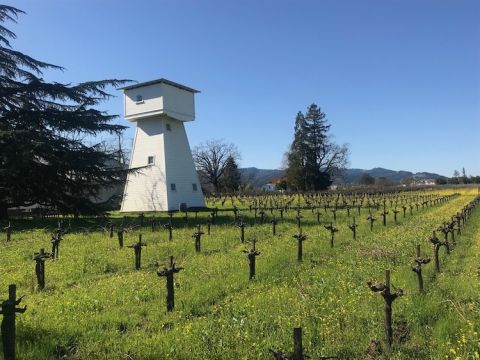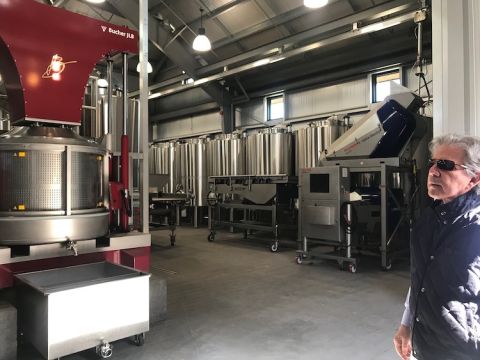Towards the end of the last century, when, admittedly, the most prominent Napa Valley wine family, that of Robert Mondavi, was in turmoil, it was said that Napa Valley’s big problem was succession, that there were so few smooth transitions of winery ownership from one generation to another.
But on my last visit to northern California last February I seemed to go from one harmonious bi-, even tri-, generational wine enterprise to another. Perhaps this is partly a reflection of the social status enjoyed by wine production in modern American society. And then there is planning.
The squire of Napa Valley today, having inherited the mantle from the late Robert Mondavi, is without question Bill Harlan. He has not only systematically built Harlan Estate into a brand that effortlessly sells at double the price of a Bordeaux first growth, and owns the luxurious social hub of the valley in Meadowood, a bucolic Relais & Châteaux resort, but famously has a business plan for the next 200 years. His latest publicly announced venture is Promontory, another wine estate that has been delegated to his son Will Harlan, but he has been hiring prominent wine professionals at such a rate that there is doubtless more in the wings.
When I asked Will Harlan about succession he made the point that in the US, 'the system is not built on passing things down from generation to generations. Generational transitions are always difficult, even putting tax aside. My dad and I have always been very aligned on where we want to go - just not always on how we get there. But I feel incredibly grateful for the support I’ve had from the founding generation.'
Just down the road in Rutherford is another father-and-son combo who toil at the earthier end of the spectrum. John Williams is in the process of handing over the organic pioneer wine estate Frog’s Leap to his son Rory, who happily says ‘I don’t really make wine to make money’ and is thoroughly committed to his father’s vines and the original ethos of the valley as a farming community. In 2007 they added the Rossi Estate to their initial holdings nearby. It was previously owned by ‘an old maid with a 52-acre [21-ha] property in Napa Valley – a popular date’, as Rory describes Louise Rossi who lived to 97 and filed with her lawyer a list of 20 people she did not want to have her land sold to.
Rory is determined to keep the old vines in the ground, however unfashionable they may be. The Rossi vineyard includes Riesling, Valdiguié, Charbono and Carignane as well as the predominant Cabernet Sauvignon. Unlike many northern California wine producers, the Williams’s have a permanent vineyard crew and find employment for them year-round. Rory echoed others’ reports that the cost of vineyard labour has doubled in the last 10 years, partly fuelled by the immigration controls of the Trump era, but added that the wages are ‘still not enough’. He is fully cognisant of how fortunate wine producers in Napa and Sonoma are to benefit from the viticultural skills of the Mexican workforce; Frog’s Leap vineyard manager Martin has been with them 25 years, his grandfather having begun working in the Napa Valley in the 1930s, 40 years before the Williams family settled there. (Yet those organising an online seminar about northern California vineyard labour couldn’t persuade a single worker to participate, so sensitive is the issue of documented v undocumented immigrants.)
Another prominent father and son, Joel Peterson and Master of Wine Morgan Twain-Peterson (see main picture), run their two separate wine businesses out of the historic stone Hooker House just off Sonoma’s leafy square. Joel, almost single-handedly, championed Zinfandel throughout the 1980s and 1990s and made his Ravenswood label such a success that in 2001 it was bought by the giant Constellation for $148 million.
Joel left Ravenswood last year to set up his own label, still specialising in old-vine Zinfandel, the cleverly named Once & Future. It’s a much smaller operation than his son’s Bedrock which, since 2007, has been scouting out some of California’s rich heritage of old vines, some as old as 140 years (Prohibition and lack of a market helped keep some of them in the ground), to make a wide array of quirky wines. ‘Thirty years of telling people Zin isn’t pink allowed me to sell bizarre varieties’, Joel says today.
Morgan, a founder member of California’s Historic Vineyard Society, is even keener than his father on the mixed, interplanted vine varieties called mixed blacks in California. ‘I like them because it recasts the conversation so that it’s about the vineyard [not the variety]. There’s much more emphasis on place now in California.’ He buys fruit for his 25 wines in eight counties but Bedrock farms about 60% of their vineyards themselves. He also tends to use larger oak than his father, who describes his winemaking technique as Burgundian.
Before getting into wine, Joel Peterson worked in a hospital alongside Chris Bilbro, who also left to set up his own Sonoma winery. Bilbro founded Marietta Cellars in Dry Creek Valley back in 1978. He died last year leaving three winemaker sons, Jake, Scot and Sam. Listening to this next generation, still apparently coming to terms with having no paternal oversight of their three separate wine enterprises, was like having a window on to a long-gone era of California wine. Dry Creek Valley was famously settled by Italian immigrants whose descendants formed a tight-knit community. I was told how the men would all go mushroom foraging together and share crusty bread, salami and rough red on the hood of a truck. Chris, a dedicated Italophile, named his winery after his Italian great-aunt Marietta who would slap him when he tried to record recipes: ‘you don’t write it down, you taste it’.
Scot runs Marietta Cellars today, continuing the winery’s brilliant red blend Old Vine Red, possibly California’s best-value wine of any colour, a concept cooked up by Chris in the 1990s when blends were out of fashion. Sam has his own operation, Idlewild, that specialises in Italian varietals, even though he has hardly been to Italy. And Jake Bilbro now owns Limerick Lane in Russian River Valley, an estate planted mainly with Zinfandel, some as long ago as 1910. And the next generation, Chris’s grandchildren, are already making their own wine.
But by no means all next generation-ers are male. Jaime Araujo’s parents established the widely admired, biodynamically run Araujo estate so successfully that they were made an offer they couldn’t refuse by François Pinault’s wine group and, renamed Eisele Vineyard, it is now a sister operation to Ch Latour of Pauillac. The Araujo parents have since set up from scratch once more, their new label being Accendo, made at their upmarket custom-crush facility Wheeler Farms, while their daughter Jaime has moved from Paris to Napa Valley to establish her own Trois Noix wine label.
This, surely exceptionally difficult-to-pronounce-in-Cailfornia, name is yet another nod to succession: to the ‘three nuts’, her and her brothers’ children. It was the Araujos' turn to organise this year's glitzy Napa Valley wine auction that has had to be postponed. One of the star lots was a Next-Gen lot organised by Jaime – a dinner at Wheeler Farms at which big bottles served by ‘the hottest young vintners’ with surnames such as Dalla Valle, Harlan, Mondavi, Phelps, Rudd, Trefethen, Truchard and Viader.
But it's not just the most established names that are benefiting from commitment from the next generation. Steve and Jill Matthiasson are some of the most admired producers of what might be called new-wave California wine and are already seeing their 19-year-old son Kai join them in their fastidious, environmentally conscious viticulture. He speaks Spanish so, according to Steve, ‘was able to fit right in’.
Some favourite wines
All these are very much easier to find in the US than the UK.
Accendo Cellars Sauvignon Blanc 2018 Napa Valley
Accendo Cellars Cabernet Sauvignon 2016 Napa Valley
Bedrock, Evangelho Vineyard Heritage 2018 Contra Costa County
Bedrock, Monte Rosso Vineyard Zinfandel 2018 Moon Mountain District
Bedrock, Bedrock Heritage 2018 Sonoma Valley
Bedrock, Old Hill Ranch Heritage 2018 Sonoma Valley
Bedrock, Pagani Ranch Heritage 2018 Sonoma Valley
Frog’s Leap Zinfandel 2018 Napa Valley
£26 The Wine Society
Limerick Lane, 1910 Block Zinfandel 2018 Russian River Valley
Marietta Cellars, Old Vine Red (Lot 69) NV California
Lot 68 is £21 Roberson
Marietta Cellars, Angeli Zinfandel 2017 Alexander Valley
£37 Roberson
Once & Future, Bedrock Vineyard Zinfandel 2018 Sonoma Valley
Once & Future, Old Hill Ranch Zinfandel 2018 Sonoma Valley
Once & Future, Oakley Road Vineyard Zinfandel 2017 Contra Costa Country
Tres Sabores, Perspective Zinfandel 2017 Rutherford
Tasting notes in California – inter-generational tasting notes. International stockists via Wine-Searcher.com.















